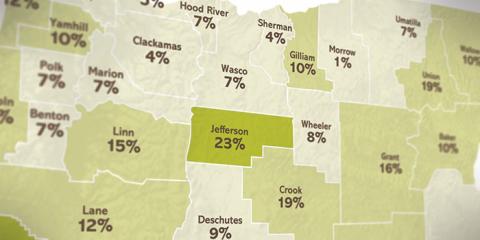Reliance on timber is a statewide phenomenon
April 23, 2013
Who knew? We certainly didn’t before doing a study.
We tend to think of forest-sector jobs as being located in rural Oregon, and indeed most of them are. After all, managing forests generally means you’re out of urban environs. But not so evident is how those jobs send economic waves through Oregon’s urban areas, too.
The Oregon Forest Resources Institute recently released the 2012 Forest Report. This data-rich resource identifies numerous interesting facts and statistics about forest-sector employment. The study identifies a total of 76,000 forest-sector jobs statewide and breaks this total down into the many and various categories of work.
A table in the report ranks the percent of each county's employment that can be attributed to the forest sector. It offers no huge surprise when it lists the most timber-reliant counties in Oregon as Lake, Jefferson, Crook, Yamhill, Douglas, Clatsop, Grant, Union and Linn counties. All have more than 10 percent of their total jobs in the forest sector. Typically, these counties have always been identified among the timber-reliant.
However, when we rank counties by the total number of forest-sector jobs in each county, surprisingly, we get a different list of timber-reliant communities. Paradoxically, the top five counties in terms of total forest-sector employment are the five most urban counties in Oregon. Multnomah, Lane, Marion, Washington and Clackamas counties combined comprise about 48 percent of the forest-sector jobs in Oregon. While these may not be traditionally thought of as timber-based counties, there is an amazing level of economic impact from the sector in these places.
And, it probably has always been that way. Timber harvest and primary manufacturing of lumber and plywood is often found in rural areas. But when you look at a broader definition of forest-sector jobs, including management, regulation, and secondary manufacturing of windows, doors, cabinets and engineered-wood products, then urban areas must also be counted as “reliant.”
It is also useful to look at these data as a way to compare the relative importance of forest-sector jobs county by county. For example, one forest-sector job in Lake County, the county with the largest percentage of forest sector jobs, is roughly equivalent to 125 jobs from all employment categories in Multnomah County, which has the largest number of forest-sector jobs.
In other words, all parts of our state are “timber reliant” in one way or another.
There are a number of ways to look at these numbers, but any way you slice it, the forest sector is a major employer in many of Oregon's counties and a major contributor to the state’s overall economy.
Proud to be employed in the forest sector,
Mike Cloughesy
Director of Forestry
